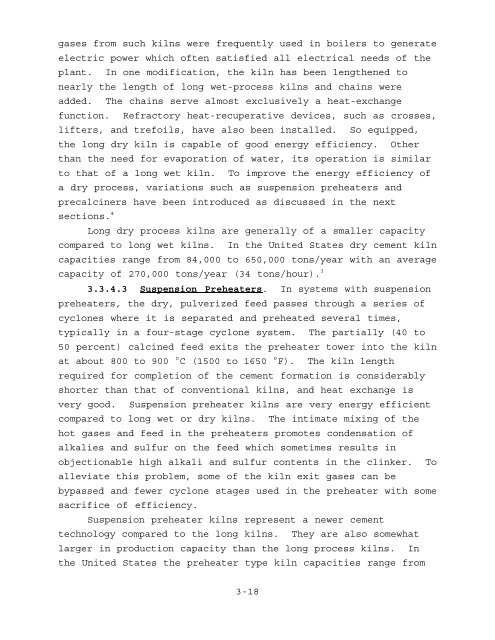NOx Emissions from Cement Mfg - US Environmental Protection ...
NOx Emissions from Cement Mfg - US Environmental Protection ...
NOx Emissions from Cement Mfg - US Environmental Protection ...
Create successful ePaper yourself
Turn your PDF publications into a flip-book with our unique Google optimized e-Paper software.
gases <strong>from</strong> such kilns were frequently used in boilers to generate<br />
electric power which often satisfied all electrical needs of the<br />
plant. In one modification, the kiln has been lengthened to<br />
nearly the length of long wet-process kilns and chains were<br />
added. The chains serve almost exclusively a heat-exchange<br />
function. Refractory heat-recuperative devices, such as crosses,<br />
lifters, and trefoils, have also been installed. So equipped,<br />
the long dry kiln is capable of good energy efficiency. Other<br />
than the need for evaporation of water, its operation is similar<br />
to that of a long wet kiln. To improve the energy efficiency of<br />
a dry process, variations such as suspension preheaters and<br />
precalciners have been introduced as discussed in the next<br />
sections. 4<br />
Long dry process kilns are generally of a smaller capacity<br />
compared to long wet kilns. In the United States dry cement kiln<br />
capacities range <strong>from</strong> 84,000 to 650,000 tons/year with an average<br />
capacity of 270,000 tons/year (34 tons/hour). 3<br />
3.3.4.3 Suspension Preheaters. In systems with suspension<br />
preheaters, the dry, pulverized feed passes through a series of<br />
cyclones where it is separated and preheated several times,<br />
typically in a four-stage cyclone system. The partially (40 to<br />
50 percent) calcined feed exits the preheater tower into the kiln<br />
at about 800 to 900 EC (1500 to 1650 EF). The kiln length<br />
required for completion of the cement formation is considerably<br />
shorter than that of conventional kilns, and heat exchange is<br />
very good. Suspension preheater kilns are very energy efficient<br />
compared to long wet or dry kilns. The intimate mixing of the<br />
hot gases and feed in the preheaters promotes condensation of<br />
alkalies and sulfur on the feed which sometimes results in<br />
objectionable high alkali and sulfur contents in the clinker. To<br />
alleviate this problem, some of the kiln exit gases can be<br />
bypassed and fewer cyclone stages used in the preheater with some<br />
sacrifice of efficiency.<br />
Suspension preheater kilns represent a newer cement<br />
technology compared to the long kilns. They are also somewhat<br />
larger in production capacity than the long process kilns. In<br />
the United States the preheater type kiln capacities range <strong>from</strong><br />
3-18

















